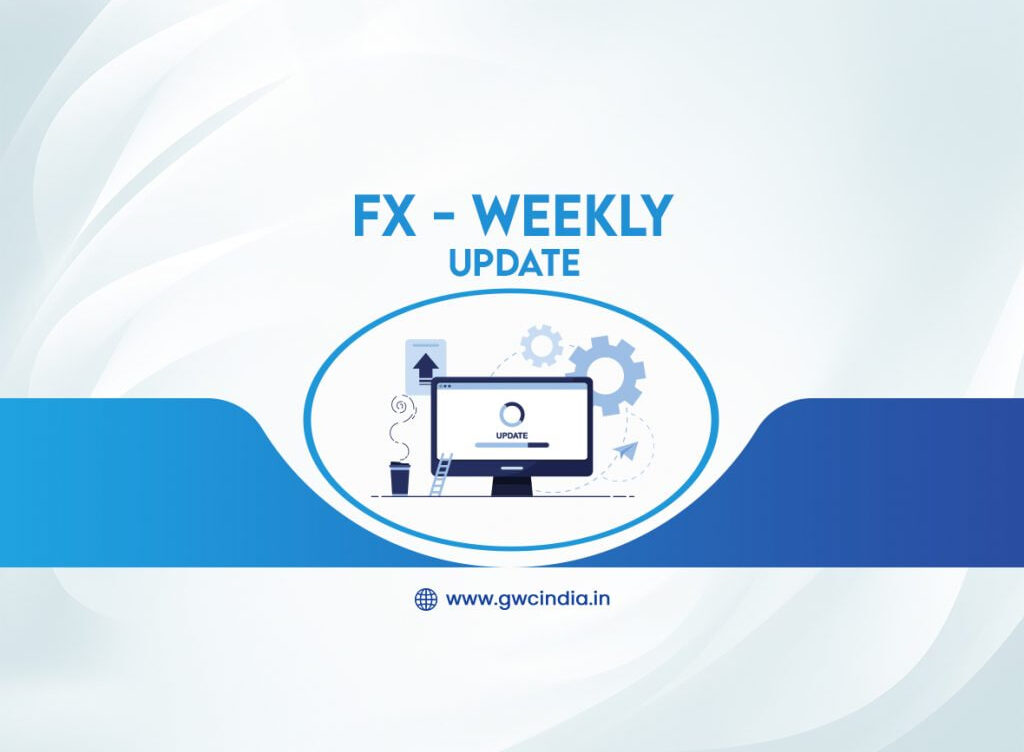FX – WEEKLY UPDATE :
Weekly SYNOPSIS: 23/08/2024
Thank you for reading this post, don't forget to subscribe!Currency Map:
|
Currency Pairs |
WEEK CLOSE |
PRIOR WEEK CLOSE |
% change |
|
USD/INR |
83.90 |
83.90 |
|
|
EUR/INR |
93.33 |
92.21 |
1.21 |
|
GBP/INR |
110.07 |
108.15 |
1.77 |
|
JPY/INR |
57.68 |
56.37 |
2.32 |
Brent Crude closed at USD 79 VS previous week close of USD 79.50. Gold closed at USD 2512. Nifty closed at 24823 vs prior week close of 24541. 10 Year G-SEC Yield is now at 6.97%.
Major developments: USDINR traded in the 83.75-83.95 range last week, and Rupee closed flat against USD w/w. EUR climbed 1.21% w/w and GBP climbed 1.77% w/w against Rupee.
Indian benchmark Equity climbed 1.14% w/w. 10 Year G-SEC Yield closed at 6.97%. 1-year fwd premia is at 2.08% p.a.
FX reserves stood at USD 674.5 bn, as on Aug 16 th. Reserves climbed US D 4.5 bn w/w.
In Aug , FPI’S have sold Rs 11694 Cr of Equities and bought Rs 7303 Cr of debt . In FY 23-24, FII’S have net bought Rs 206279 Cr of Equities and have net bought Rs 123120 Cr of debt.
Indian services purchasing managers’ index rose to 61.1 from 60.5 last month, while the manufacturing purchasing managers’ index increased slightly to 58.5 from 58.3 in June. That drove the composite PMI to a three-month high of 61.4 from 60.9 the previous month.
Rupee’s magnitude of decline is increasing, though it is still not clear as to whether it is due to Global risk aversion. RBI’S increasing flow absorption is distorting USDINR’s real path. With US index down and crude remaining soft, it is still a paradox as to why RBI is not allowing two way movement within a larger range. This implies that Rupee’s strength even marginally is doubtful and a well-controlled decline along or more than fwd curve could be expected. Since US inflation is expected to decline to 2.5% and Indian inflation is expected to average 4.75%, we could expect 2% decline in Rupee on y/y basis.
USDINR fwd premia has already touched 2.10% p.a. for 1 year. It is expected to expand to 2.5% by Dec end as Fed starts cutting rates.
Hedging advise: Imports be hedged on decline to 83.70. Exports be hedged in the 84.10+ range for less than 3 months.
Global developments: US Indices rallied, USD weakened and Treasury yields settles lower after Fed Chairman’s speech.
Fed Chairman Powell acknowledged the progress the Fed has made over the past two years, specifically noting that the upside risks to inflation have diminished while the downside risks to employment have increased. While Powell offered nothing in terms of the speed of adjustment, other policymakers speaking this week highlighted the importance of a “gradual” and “methodical” approach to loosening policy, which supports a 25 basis point cut in September. However, Powell also emphasized that the FOMC “does not seek or welcome any further cooling in the labor market”, which suggests the next several employment reports will be critical in determining the future path of the policy rate.
Fed appears well on track to cut interest rates at the September meeting after a “vast majority” of officials indicated that in the minutes of its July 30-31 meeting. The minutes, in fact showed, that some policymakers would have been willing to reduce borrowing costs at the July meeting.
Focus will be on US Core PCE index release on Friday.
ECB’s July minutes revealed that the upcoming September meeting is “widely seen as a good time to re-evaluate the level of monetary policy restriction,” with members emphasizing the importance of approaching that meeting with an “open mind.”
The data-dependent approach was reiterated, but with a clear message that this does not mean overemphasizing specific, single data points. Instead, the policy decisions should be guided by established elements of the reaction function.
UK’s PMI data for August showed positive momentum across both the manufacturing and services sectors. PMI Manufacturing edged up from 52.1 to 52.5, surpassing expectations of 52.2 and marking a 26-month high. PMI Services also rose from 52.5 to 53.3, above the expected 52.8. This led to PMI Composite increase from 52.8 to 53.4.
Chief Business Economist at S&P Global Market Intelligence, highlighted the significance of these figures, noting that “August is witnessing a welcome combination of stronger economic growth, improved job creation, and lower inflation.” He emphasized that both manufacturing and service sectors are showing solid output growth and increased job gains, with business confidence remaining historically high.
Eurozone PMI Manufacturing fell slightly from 45.8 to 45.6 in August, an 8-month low and below expectations of 46.1. In contrast, PMI Services showed a strong performance, rising from 51.9 to 53.3, surpassing the expected 52.2. This divergence led to a modest increase in PMI Composite, which climbed from 50.2 to 51.2, signaling faster expansion.
Currency technical levels: USDINR: 83.76/83.65 (Supports), 84.10 (resistance),
EURINR:94(Resistance),91.65/
GBPINR: Supports: 108.80( supports), Resistance:110.25/112.45(
JPYINR: Resistance:57.50/59.50, Supports: 55.50/54.50 (support).
Hedging advise: USDINR imports be hedged on decline to 83.70. EUR nearby payables be covered on dips. GBP receivables can be covered at 112+.
Click to open an Account : https://ekyc.gwcindia.in/client/


